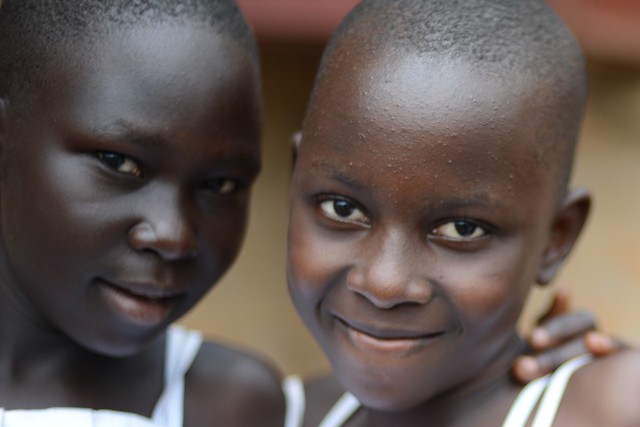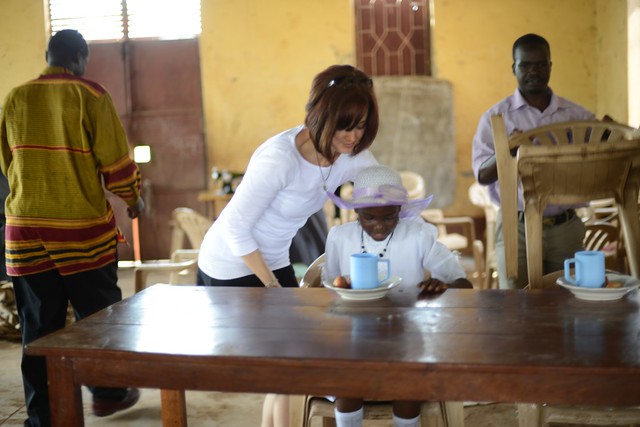I have been meaning to post this article for you, from A Holy Experience for a while now.
No excuses, but issues with the computer...
I was touched. So WEC CAN make a difference.
From the Front Cover article of Christianity Today this month, June 2013
The academic research that proves with data that child sponsorship works.
Compassion
was the only child sponsorship program that willingly agreed to having
their long-term effectiveness studied — and here are the results from
Dr. Bruce Wydick, professor of economics at the University of San
Francisco.
Startling:
Chu put out some feelers with Compassion’s research director, Joel Vanderhart, who decided to risk what no other child-sponsorship organization was willing to risk at that point:
to allow its program to be scrutinized.
And with that, our strategy for identifying the causal impacts of the program became clear.
We would obtain early enrollment lists from different village
projects introduced during the 1980s, and track down the families of
those who were first sponsored in these projects.
Then we would obtain information
on the life outcomes of these formerly sponsored children—now adults—and
compare them to their adult siblings who had been slightly too old to
be sponsored when the program arrived in their village. In this way we
would be able to control for genetics, family environment, and a host of
other factors that the siblings held in common. The only
difference that could affect adult life outcomes across the sample would
be the fact that Providence had allowed some of these siblings and not
others to be age-eligible for child sponsorship.
The Results
Chu found a partner for her research project: Laine Rutledge, now a
doctoral student in economics at the University of Washington.
The two graduate students spent the summer of 2008 in Uganda,
where they obtained data on 809 individuals, including 188 who were
sponsored as children. A couple of months after they returned, Chu and
Rutledge stopped by to share the results.
Looking at the results of Compassion’s impact on educational outcomes in Uganda — I stared at the statistics on my screen to make sure I was seeing correctly.
“This is … amazing,” was all I could mumble. We tried slicing the data different ways, but each showed significant educational improvements.
You could beat this data senseless, and it was incapable of
showing anything other than extremely large and statistically
significant impacts on educational outcomes for sponsored children.
A few months later, I presented
the Uganda findings in the weekly development economics seminar at
UC–Berkeley. The Berkeley seminar was familiar turf, but not a place to
suffer fools gladly. We received a number of constructive comments, but
the consensus was that the underlying methodology was sound. What was
obvious was that the study needed external validity.
Uganda was one country. We would try to expand the study.
By August 2010, we had obtained
data on 10,144 individuals over an array of variables: primary,
secondary, and tertiary education; type and quality of adult employment;
community leadership; church leadership; assets owned as adults; and a
number of other variables that would measure that slippery word that
economists love, development.
The results in our other five countries confirm the positive impact of Compassion’s child-sponsorship program in Uganda.
In all six countries, we
find that sponsorship results in better educational outcomes for
children. Overall, sponsorship makes children 27 to 40 percent more
likely to complete secondary school, and 50 to 80 percent more likely to
complete a university education.
To put it simply, thes educational impacts of sponsorship are large
—roughly equal to the substantial effects of the Rosenwald Schools
program that from 1913–31 educated blacks in the Jim Crow South. They
are roughly double those of Oportunidades, the celebrated
conditional-cash-transfer program that gives cash to mothers in Mexico
for keeping their children in school.
Compassion’s results extend beyond school attendance. We found that
child sponsorship means that when the child grows up, he is 14–18 percent more likely to obtain a salaried job, and
35 percent more likely to obtain a white-collar job.
Compassion
asked me to visit Colorado Springs to present the results of our
research. I had an appointment with Wess Stafford, then president of
Compassion.
Stafford greeted me with a warm handshake and ushered me into a comfortable chair in front of his desk.
“Your program works,” I said.
“I know,” he smiled.
“But I am analyzing this data as a dispassionate scientist, not as an advocate of
Compassion like yourself,” I replied. “We’re not just finding positive correlations, but
substantial causal effects from the program—in every country—especially Africa. I’m wondering what is happening here. You’re a former academic.
I think there is something deeper going on in the program that would interest the greater development community. I need some leads.”
I raised my eyebrows. “Hope?”
Hope is a fuzzy concept for economists. I squinted my eyes. He explained:
For my dissertation, I asked a bunch of kids what they wanted to be when they grew up. Some were Compassion kids, some were unsponsored. There was a little bit of a difference between the two groups.
But then I asked them later what they realistically expected to be when they grew up.
Here, there was a big difference between the sponsored kids and the other kids. You see, poverty causes children to have very low self-esteem, low aspirations.
The big difference that sponsorship makes is that it expands children’s views about their own possibilities.
Many of these children don’t think they are capable of much.
We help them realize that they are each given special gifts from God
to benefit their communities, and we try to help them develop
aspirations for their future.” ~Wess Stafford, Compassion
So — Did sponsored children have higher aspirations than nonsponsored children who were just like them in other ways?
We carried out three studies—in Bolivia, Kenya, and Indonesia—with
1,320 children. The sample included sponsored children, their
unsponsored siblings, and other unsponsored children from the same
communities.
In each of the studies, we found that sponsored children
consistently had significantly higher expectations for their own
schooling than unsponsored children, even when controlling for family
and other factors.
They also generally had higher
expectations for adult employment. (Years later, a disproportionate
number of Kenyan kids still wanted to be pilots.) Many of these findings
came close to mirroring the adult differences we measured between
formerly sponsored children and nonsponsored children.
The puzzle pieces are beginning to fall into place: the patient
nurturing of self-worth, self-expectations, dreams, and aspirations may
be a critical part of helping children escape poverty.
Overall, when we combined these characteristics into
aggregated psychometric indices, controlling for other factors, we found
that Compassion
children’s drawings displayed significantly lower levels of
hopelessness, higher levels of optimism and self-efficacy, and higher
levels of overall happiness.
We can’t yet establish a clear
causal link between the increased levels of hopefulness and aspirations
among sponsored children and their improved adult lives.
But the puzzle pieces are beginning to fall into place:
the patient nurturing of self-worth, self-expectations, dreams, and
aspirations may be a critical part of helping children escape poverty.
It is a holistic approach that secular antipoverty initiatives have
largely downplayed, but an approach that Christian development groups
have championed for decades.
The traditional approach to development work has been to provide
things for people. If people lack education, we build them schools. If
they are unhealthy, we build them hospitals and provide doctors, or we
drill a freshwater well. If their small businesses are stagnant, we
provide microcredit so they can borrow.
While each of these interventions can be helpful in the right context, mere provision fails to address the root of poverty: the behaviors, social systems, and mindset that are created by poverty.
The key to ending poverty resides
in the capacity of human beings—and their view of their own capacity—to
facilitate positive change.
Indeed, every time we provide something for someone else in need, we
send a subtle message to them that we believe they are incapable of
providing for themselves.
While some interventions are
necessary, especially in the area of health, they come at a cost of
reinforcing an inferiority complex among the poor. Good development
organizations understand this. Along with providing some basic resources
that allow children to progress farther in school, the
child-development approach advocated by Compassion appears to get under
the hood of human beings to instill aspirations, character formation,
and spiritual direction.
In short, it trains people to be givers instead of receivers.
When someone asks me what an ordinary person can do to help the poor in developing countries, I tell them about our research.“
Compassion works.
Sponsor a child for only a bit more than a dollar day — and the hard data proves that you change the world.
And us who get to give sacrificially — are the one who get to live richly.
You get to give the ingredient that makes a difference: HOPE — in Jesus’ name.
Coming — stories of #FarmgirlsinAfrica with
Kisses from Katie … and how we fell in love…
Related #FarmGirlsinAfrica :
Will you take one moment today and look into one face here and pray for just one by name, right now
– your real way of reaching out to a child and not turning away–
pray for the beginning of a real-life love story:










